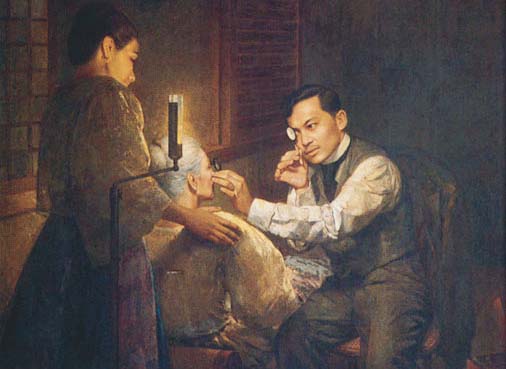First published in Tulay Fortnightly, Chinese-Filipino Digest 25, no. 3 (July 10-23, 2012): 5.
Was Rizal anti-Chinese?
There is no simple answer. It has been raised several times in the entire year (June 2011 to June 2012) of celebrating the 150th birthday of Dr. Jose Rizal, our national hero.
History neither happens in a vacuum, nor can it be easily judged through hindsight. Historical events, philosophy, human behavior take place and are influenced by the social environment prevailing at the time. We cannot pass judgment now on Rizal’s supposed anti-Chinese sentiments without considering the social context of such behavior.
The turn of the 19th century was a period when most intellectuals, ilustrados foremost among them, were just starting to develop national consciousness and staking their claims on the Filipino national identity. Writings of Pedro Paterno and Gregorio Sancianco had great influence on the transformation from parochial to Filipino national identity. They encouraged Filipinos to veer away from thinking of themselves and being Caviteño, Batangueño, Cebuano, Ilonggo, Ilocano, or Tagalog and learn to assert that they are Filipino.
Rizal allegedly spurning the Chinese should be seen in the context of that social environment. I wouldn’t call it simplistically as anti-Chinese per se but more of anti-foreign sentiments. Both Filipinos and Chinese were oppressed, ridiculed and downtrodden by Spanish colonizers, and Filipinos then took their cues from these foreign rulers.
Moreover, the Chinese during Rizal’s time were mostly illiterate, barefooted, lowly vendors and workers in tattered and dirty clothing, not because they were inherently uncouth, but mainly because they could not afford decent wear, had no time for social amenities nor personal hygiene.
Rizal’s ridicule of these characters, again, should be seen in the context of social class distinctions. Rizal came from an elite, landed and educated family. Rather than anti-Chinese racism, I see it more as an elitist anti-lower class attitude. It is an attitude perpetrated and perpetuated by Spaniards who massacred, persecuted and exiled the Chinese. So, how do you expect Filipinos to behave towards the Chinese then?
The Quiroga character in Rizal’s novel Noli Me Tangere is the epitome of what is objectionable to Filipinos then: people who curry favors from public officials out of self-interest. But reading the Quiroga character from the backdrop of the prevailing environment, it is clear his actions were motivated by self-preservation in a hostile environment. His character is a mirror of Mr. Ah Q, a character in Tales of Ah Q, created by Lu Xun (魯迅), 20th century liberal Chinese writer. Ah Q was invariably portrayed as a mercenary, pushover, self-flagellant, lawbreaker, and above all, a survivor.
We Tsinoys are turned off too by some of the new immigrants from China who talk loudly in public places, refuse to turn off their mobile phones, spit and smoke anywhere, and look down on our public servants and officials. The question is, if we spurn such behavior, are we being anti-Chinese?
On the other hand, Rizal showed admiration for the Chinese and took pride in the early Filipinos’ contacts and relations with them. He read and quoted Chinese accounts describing the Philippines and early Filipinos as an advanced civilization. He also used these accounts to refute and annotate Antonio Morga’s Sucesos de las Islas Filipinas to show how cultured early Filipinos were and how enlightened pre-hispanic Philippine civilization was. This, by no means, can be considered anti-Chinese.
A society is made up of a rainbow of colors and there have been different opinions about Dr. Jose Rizal, including whether he should be considered national hero or not. The important thing is not to tarnish the sacrifices and martyrdom of our heroes by passing judgement on acts of commission and omission.
Racism
The issue of racism is always an explosive one.
The 2010 Rizal Park hostage-taking fiasco and the 2012 conflict over the Panatag (Scarborough) Shoal have brought to fore that unless handled carefully, social issues can sometimes be overlaid with racism and racial overtones. Ethnic minorities in any society often have to watch their steps more carefully than members of mainstream society.
The very question “Where do the ethnic Chinese stand in the Scarborough shoal conflict” is a loaded one. Without considering whether there is a right or wrong side, the question presumes the ethnic Chinese will either side with the Filipino mainstream or with the Chinese. A political issue is reduced to a racial one.
We are reminded of World War II when many Japanese could not accept their country was going to war against the United States and the Philippines in the same way many Germans did not support Hitler’s anti-Semitic war.
This is the same situation when ethnic Chinese employers are accused of abusing their Filipino employees and vice-versa. An employer-employee relationship that turned sour is overlaid with racial undertones because of the different ethnicity. In the same way, the Mindanao conflict is often unfairly reduced to a Muslim-Christian conflict when the issues are political and economic, not religious, in nature.
Lessons in history are important for us to understand and learn from so we do not repeat the mistakes of the past. An enlightened and informed background is essential before judgment can be passed, if at all, on historical events.





